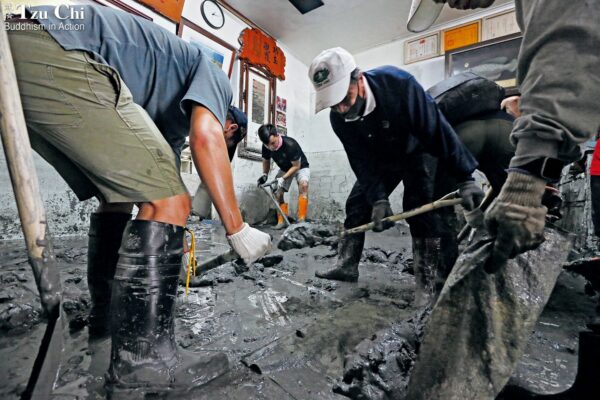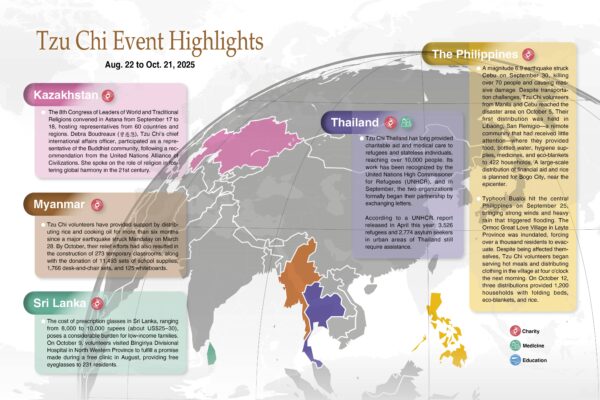By Li Qiu-yue, Tzu Chi Teachers Association
Translated by Wu Hsiao-ting
Graphic by Zhong Ting-jia
Audio-visual resources and hands-on experiences are effective methods to foster students’ environmental awareness amid the demands of a full curriculum.

A teacher asked: “I want to share the importance of environmental protection with students, but parents want me to spend more time improving exam scores. How can I strike a balance between the two?”
The aim of education is to help students become well-rounded in morality, intelligence, physical fitness, social skills, and aesthetics. While teachers and students in junior and senior high schools face pressures related to academic advancement and the pace of the curriculum, it is vital that environmental education is not neglected. Failing to teach and implement environmental protection is certain to yield adverse consequences for global citizens.
What is the best way to strike a balance between improving academic exam scores and sharing the importance of environmental protection? Teachers can consider the following methods:
Use audio-visual resources
Teachers can allocate five minutes of class time to watch a short environmental video, making efficient use of valuable time without significantly disrupting the schedule. I did this before I retired as a schoolteacher, and favored public service commercials from Tzu Chi’s Da Ai TV and thought-provoking videos produced by academic institutions or environmental organizations. I remember watching with students a memorable scene of a polar bear on a slowly sinking, drifting iceberg. The polar bear gently waved its paw, singing, “The time has come; I must bid you farewell.” Eventually, the polar bear and the iceberg were submerged into the sea. There was no gore, no loud cries, only a poignant and overwhelming sense of loss.
After the video, Student A asked, “Teacher, how can we save polar bears?” Student B followed with, “How many polar bears are left now?” I tasked them with researching at home and sharing their findings the next day.
During the subsequent sharing session, they highlighted that adopting a vegetarian diet could slow down global warming, thus preserving polar bear habitats. One student mentioned, “Due to global warming and climate change, the Arctic is warming four times faster than other parts of the world.” Another student added, “The polar bear population in Churchill, northern Canada, has declined by nearly half since the 1980s.” These environmental facts inspired students to consciously reduce their carbon footprint. The seeds of environmental awareness had quietly taken root and sprouted in their hearts.
Share short articles
I’ve noticed that environmental conservation is well taught and effectively implemented in elementary schools in Taiwan. However, there is a decline by teachers in actively promoting environmental awareness as students progress to secondary school.
As a former schoolteacher, when time constraints hindered video viewing, I provided short articles for students to read and write reflections on. This approach not only enhanced their environmental knowledge but also cultivated their writing skills.
Over a decade ago, when the movie 2012 was released, I encouraged my students to watch it. Shortly afterward, I came across a compelling article by Mr. Zhuang Xiao-ming (莊曉明), titled “The Catastrophes of Nature.” I promptly shared it with students for a reflective writing piece. Nearly everyone’s reflections referred to these words by Mr. Zhuang: “Forgetfulness has become a common excuse for people to repeat their mistakes. When heaven cannot awaken people to their foolish actions, the only way to get their attention is through recurring destructive forces, such as unusual weather and disasters.” Such articles prompted students to contemplate questions like: “What terrible damage has humanity done to the Earth?,” “How can we achieve energy conservation and carbon reduction in our daily lives?,” or “How can we avoid harming the ecosystem?” When these reflections lead to action, I’ll have achieved my goal.
Introduce hands-on experiences
In an effort to deepen students’ awareness of environmental protection, I once organized activities where students and parents joined me in cleaning up litter at parks and Monkey Mountain in Kaohsiung, southern Taiwan. Students returned with the following observations: “Many residents were careless with cigarette butts. I collected over a hundred of them today!,” “Someone had shoved an unfinished beverage can into a tree branch, forcing us to climb the tree to retrieve it. A classmate ended up getting the remaining beverage spilled on him!,” and “It’s sad to see the beauty of the mountain marred by used tissues, filled garbage bags, and beverage cans. We must speak up and remind people it’s everyone’s responsibility to love the Earth.”
These experiences inspired my students to reduce their use of disposable utensils and carry their own water bottles when going out. When they noticed classmates drinking beverages, they reminded them to rinse the container and put it in the recycling bin after finishing their drink.
Convenience often trumps environmental considerations in today’s fast-paced modern life. Emphasizing environmental protection becomes ever more crucial. Even amidst academic pressures, teachers can effectively encourage eco-consciousness by using resources like short films and articles. Let’s dedicate time to raising environmental awareness, fulfilling our responsibility as Earth citizens and contributing to the well-being of future generations on our blue planet.



